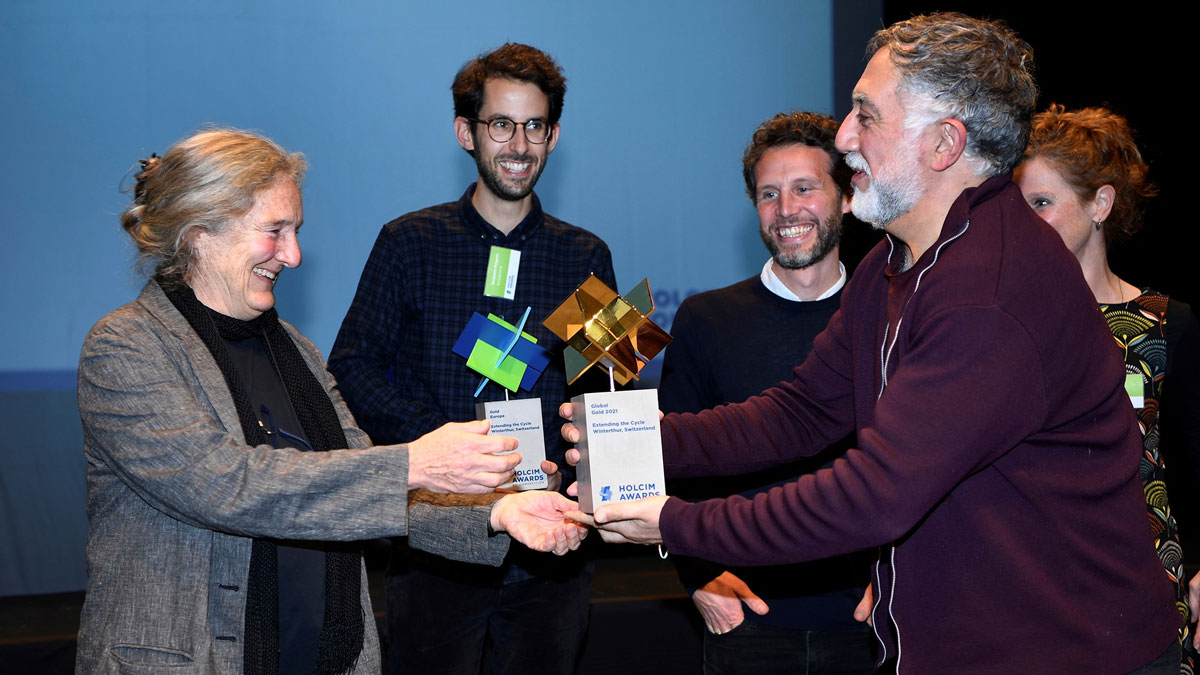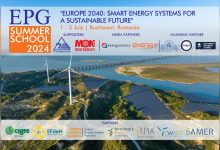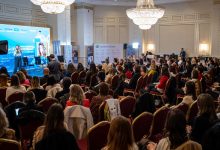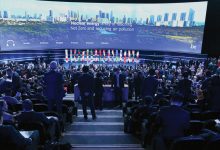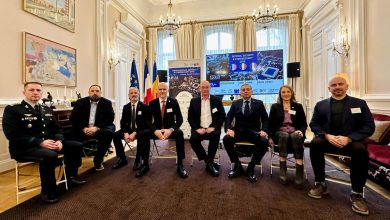Global Holcim Awards for Sustainable Construction
The winners of the global Holcim Awards for Sustainable Construction showcase the cutting edge of approaches to sustainable design, green architecture, and materials innovation. In the 6th cycle of the world’s most significant competition for sustainable design, offering prize money totalling USD 2 million, most of the global prizewinning projects came from the Asia Pacific and Middle East Africa regions; one top prize each also went to Colombia and Switzerland. The prizes were presented at a handover ceremony at the International Architecture Biennale in Venice, Italy.
The Holcim Awards competition is conducted in two phases. In the first phase, independent juries of international experts evaluate the project entries in the competition regions Europe, North America, Latin America, Middle East Africa, and Asia Pacific. The decisive factor here is the holistic approach to sustainability, which in the context of the Holcim Awards is based on the five pillars of Progress, People, Planet, Prosperity, and Place. The projects that address these five concerns most consistently and coherently are awarded prizes at the regional level.
The prizewinning projects automatically qualify for the second phase of the competition: the Global Holcim Awards, in which the entries are evaluated by a global jury, which was chaired by Hashim Sarkis (Lebanon/USA) in 2021. Participants were invited to submit additional material on their projects, including detailed information on the carbon footprint of their project over its entire life cycle and the project’s contribution to the circular economy. 33 projects were qualified for the Global Holcim Awards. The jury ultimately decided on four Awards carrying total prize money of USD 350,000. The Global Holcim Awards Bronze was awarded to two winners ex aequo. The winning projects are located in Colombia, Morocco, Switzerland, and Vietnam. In addition, four non-monetary Commendations went to Australia, Cabo Verde, Jordan, and the Philippines.
Addressing climate change and circular material flows
The issue of sustainability is of paramount importance in construction. In view of climate change and diminishing resources, new approaches are needed along the entire value chain of the construction industry as the building sector moves toward net-zero emissions and circular material flows. Developing and applying these new approaches are what the Holcim Awards promote.
The number of competition entries shows how intensively specialists in the fields of architecture, engineering, urban planning, materials science, construction technology, and related disciplines deal with sustainability issues: A total of 4,742 projects from 134 countries were submitted in the 6th cycle of the competition. Around half of the entries worldwide were entered in the Next Generation category, which seeks bold ideas and visionary concepts by participants up to 30 years of age. The 21 winning projects in this category were announced in virtual ceremonies earlier this year. The 33 Main category winners of the regional and global competitions were invited to the International Architecture Biennale in Venice, where they received their prizes at a single handover ceremony.
Facing the challenges of a more inclusive built environment
The high quality of the projects assessed by the Global Holcim Awards jury was undisputable – after all, all 33 projects had already won prizes in their respective regions. Nevertheless, “all the projects made remarkable progress since the regional phase,” said the Head of the Academic Committee of the Holcim Foundation, Marilyne Andersen, who was a member of all five regional juries and the global jury. The ambitious projects embody compelling visions and holistic concepts. “Some projects show that there is value even in what we destroy or throw away,” says Andersen. “Others make valuable attempts to upgrade whole ecological systems, thereby correcting manmade mistakes of the past.” Still other projects aim not only to preserve cultural traditions and characteristics but to carry them into the future. “Particularly touching were the projects that dealt with the resilience of people in dire circumstances,” says Andersen. As a whole, the projects clearly showed how diverse the challenges of sustainable construction are, from energy & waste management to issues of land use & restoration, local culture & action, materials and their reuse, and technology & policy.
Making new from old in Winterthur, Switzerland
Global Holcim Awards Gold (USD 150,000)
Extending the Cycle: A building that is primarily constructed with salvaged materials.
Winners: Marc Angst, Michèle Brand, Barbara Buser, Pascal Hentschel, Benjamin Poignon, Kerstin Müller, baubüro in situ, Basel, Switzerland.
This project redefines the starting point of the design process by treating demolition as an opportunity to source construction materials. An industrial building is preserved, repurposed, and expanded by 3 stories to house 12 residential units. The additional stories are built using materials reclaimed from demolition sites. The design process started with the collection of salvaged building elements and materials. The materials were then catalogued and their potential for reuse was determined.
“The project as such does not make a big impact in the world of architecture,” says prizewinner Barbara Buser, “but it’s the way of thinking about architecture, about construction, about participation, that will have to change all over the world.” The Global Holcim Awards jury highly commended this project for the disruptive construction methodology it proposes to achieve carbon-neutral buildings and enable circular-economy models in the field of design and construction. The project demonstrates how much potential exists – and is lost – in buildings that are torn down, to the extent that dismantled elements are reused as components for new construction. “The project applies circularity in construction to a level of near perfection,” praised jury member Marilyne Andersen.
Wetland Vitality in Colombia – Project OverviewSymbiosis between humans and nature in Bogotá, Colombia
Global Holcim Awards Silver (USD 100,000)
Wetland Vitality: A landscape design project for environmental recovery and social sustainability.
Winners: Edgar Mazo, Sebastian Mejía and team, Connatural, Medellín, Colombia.
This project aims to consolidate the Jaboque wetlands. The consolidation is achieved along a 5.5 km-long linear park that integrates recreational and natural areas and offers educational opportunities for the community. The landscape planning was used as an opportunity to create a live botanical collection. Plants were selected depending on their impact on the ecosystem and their potential to strengthen the wetland flora and fauna.
“The project embodies sustainable concepts through different approaches,” explains prizewinner Sebastian Mejía. “It recovers the ancestral relationship between humans and their territory. Also, it aims to establish a symbiotic relationship between wetlands and urban development, assuring the preservation and the strengthening of this fundamental ecosystems for climate-change adaptation.” The Global Holcim Awards jury found that the project integrates a wise, sustainable, pluralistic, and participatory logic, aiming to repair a long-lost relationship between local communities and nature through wetland restoration. “What is really impressive is how much effort and research went into the details to figure out what exactly was needed,” says Marilyne Andersen.
Cultural Interlude in Morocco – Project OverviewSustainable oasis upgrade in M’hammid El Ghizlane, Morocco
Global Holcim Awards Bronze ex aequo (USD 50,000)
Cultural Interlude: A self-sustaining center to preserve tribal cultural heritage.
Winner: Aziza Chaouni, Aziza Chaouni Projects, Fez, Morocco & Canada.
The oasis in the Drâa Valley in southern Morocco is losing its inhabitants, and along with them its heritage. This project aims to help preserve local life and culture by creating a self-sustaining cultural centre in the town. It incorporates traditional construction with appropriate technologies such as solar chimneys and solar-powered geothermal systems along with passive systems like composting toilets and rainwater harvesting for both domestic and irrigation purposes.
“The project lies in the Sahara Desert at the fringe of an arid oasis acutely lacking water resources, so it has no choice but to be sustainable,” explains prizewinner Aziza Chaouni. “It needs to generate its own energy, collect its own water, and distribute it in a very efficient manner to make use of every single drop of water.” The Global Holcim Awards jury recognized the laudable intention to address the issue of tribal-community displacement due to the threat of climate change by suggesting a design solution that enables people to remain rooted in their hometown and maintain their traditions. “This project combines many different elements into a whole that serves a bigger purpose,” sums up Marilyne Andersen.
Propagated Sanctuary in Vietnam – Project OverviewReforestation program in Hanoi, Vietnam
Global Holcim Awards Bronze ex aequo (USD 50,000)
Propagated Sanctuary: The cultivation of an urban forest and economic catalyst.
Winners: Marek Obtulovic, Nguyen Duc Trung, Mai Lan Chi and team, ODDO Architects, Hanoi, Vietnam.
A large group of volunteers plans to restore the subtropical forest on Banana Island, a 26-hectare island in the Red River. By planting endemic trees and plants, the project aims to introduce abundant greenery within the urban fabric, reduce carbon emissions, and multiply the number of native species. The flora will enable animals to return to their natural habitat, boosting regional biodiversity. The project will also create an educational recreational area for Hanoi residents and an open-air laboratory for interested scientists and research institutions.
“We want to restore part of the island to the condition it used to be in,” explains prizewinner Marek Obtulovic. “It’s about renaturation, not about creating flower beds and green lawns.” The jury recognized the clear relevance of this proposal for Hanoi and highly commended the way landscape design is deployed to integrate the urban and natural environments. According to the jury, this proposal stands out as a bold act of awareness that shines an urgent spotlight on the recognition of green infrastructure in Vietnam. “This project adds public space to the city in very interesting way, offering many strong benefits and opening new perspectives,” adds Marilyne Andersen.
Connective Threads in Jordan – Project OverviewClothing recycling in the Zaatari Refugee Camp, Jordan
Global Holcim Awards Commendation
Connective Threads: Shelters for refugees using upcycled textile waste.
Winners: Azra Aksamija and the MIT Future Heritage Lab team, Cambridge, MA, USA.
The world generates over 80 billion square meters of discarded or unused garments every year. Creating value by coupling that waste with the human potential of refugee camps is the idea behind this project. Modular tapestries are created that can be used to make refugee shelters for displaced Syrians. “This project is touching because it brings back pride to refugees by introducing a subtle piece of their culture to their lives,” says Marilyne Andersen. The Global Holcim Awards jury appreciated the project’s support of cultural resilience of displaced communities through the promotion of cooperative-based practices. “Our project addresses problems of cultural infrastructure and refugee camps and mitigates the lack of opportunities of displaced people to access means of cultural resilience,” explains project author Azra Aksamija.
Empowering Homeless in the Philippines – Project OverviewEmpowering the homeless in Minalin, Philippines
Global Holcim Awards Commendation
Empowering the Homeless: Sustainable social housing for homeless families.
Winners: Prasoon Kumar and Robert Verrijt, Billion Bricks, India and Singapore.
This project combines social housing for 125 homeless families and a solar power plant that will produce and sell enough energy to finance the development. The roofs of the buildings are covered with photovoltaic panels that will generate 25 times more power than the residents will need. The surplus energy will be sold, and the revenue will be used initially to pay off the construction of the buildings. “What is remarkable is the model that this project is based upon,” says Marilyne Andersen. The Global Holcim Awards jury was impressed by the project’s ability to fully and creatively bring together different stakeholders to address two urgent societal issues: homelessness and access to renewable energy sources. “We hope to make housing affordable for everyone,” says project author Prasoon Kumar.
High-Performance Tower in Australia – Project OverviewExtreme sustainability in Sydney, Australia
Global Holcim Awards Commendation
High-Performance Tower: A new sustainability model pursuing low-energy and high-comfort performance.
Winners: Wolfgang Kessling, Transsolar Energietechnik, Germany; Edwin Chan, EC3 Design, USA; James O’Callaghan, Eckersley O’Callaghan, United Kingdom;Corie D. Sharples and Andreia Taixeira, ShoP, USA; Ric Wang, Atlassian, Australia; Njnotschka Titchkosky, BVN, Australia.
The high-performance tower is a 39-storey building accommodating 4,000 workplaces. Introducing a new sustainability model, the design addresses an expanded program, incorporates next-generation systems, and presents an innovative typological and structural concept. The design pursues low-energy and high-comfort performance, because “a good working environment is a very attractive asset,” says prizewinner Wolfgang Kessling. The Global Holcim Awards jury commented that the design successfully combines structural, environmental, and programmatic elements to achieve its goals in terms of sustainability and considers the building a remarkable contribution to sustainable architecture that is greater than the sum of its parts. “This project can be a source of inspiration for companies who want to build sustainable high-rises,” says Marilyne Andersen.
Rebuilding Erupts in Cabo Verde – Project OverviewCommunity rebuilding in Chã das Caldeiras, Cabo Verde
Global Holcim Awards Commendation
Rebuilding Erupts: A post-disaster community reactivation facility.
Winners: Leão Lopes and team,M_EIA/Atelier Mar, São Vicente, Cabo Verde.
Following a disastrous volcanic eruption in 2014, the government of Cabo Verde decided to create a masterplan for the sustainable rebuilding and redevelopment of a destroyed village. Within this plan is a design for an educational complex conceived as a catalyst for the reactivation of community life. The buildings are being erected by locals trained in specific construction methods. “The majority of the school is built with elements fabricated on site and produced by the people of the community,” says prizewinner Leão Lopes. The Global Holcim Awards jury highly commended the project’s top-down approach and praised the low-tech yet effective design and construction methods. “This project is all about resilience, and it shows very well what it takes to rebuild an existence in a sustainable way,” says Marilyne Andersen.
Prizewinning projects and author teams online
The Main category winning projects and authors of the 6th Awards were honoured at a hybrid event on 13 November 2021. A film of the handover ceremony and virtual presentations of all winning projects, including detailed descriptions, videos, jury reports, and statements by the authors as well as numerous illustrations, are available at www.holcimfoundation.org/awards. In addition, the latest book of the Holcim Foundation features in-depth interviews with the prizewinning authors: www.holcimfoundation.org/publications.
Holcim Foundation for Sustainable Construction
The Holcim Foundation for Sustainable Construction was created in 2003 by Holcim as an independent legal entity to raise awareness of the important role that architecture, engineering, urban planning, and the building industry have in achieving a sustainable future. The Holcim Group is a global leader in innovative and sustainable building solutions and enables greener cities, smarter infrastructure, and improved living standards around the world. The company is driving the circular economy as a world leader in recycling in order to build more with less.


